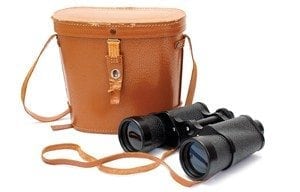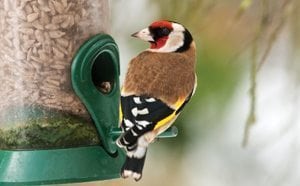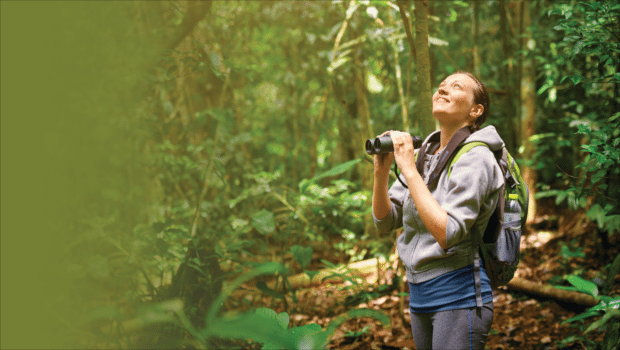Bird-Watching for Beginners
Start with a Bird Feeder and Binoculars
For those that love animals but can’t provide a home to a domestic pet, wild birds are just outside the window. Between 50 and 60 million Americans list bird-watching as a hobby. To start, all we need is a bird feeder.
For safety and comfort, position feeders near a tree or bush at least 15 feet from windows. Scott Logan, an Audubon Society board member in Sherman Oaks, California, cautions, “Birds stay alert for predators. An unmarked window looks like an escape route. They won’t see the glass.” Products like Window Alert, a decal that reflects ultraviolet rays birds see but humans don’t, can prevent a crash.
A book on local birds will describe the best food to attract them, whether residents or just passing through. Bluebirds love mealworms. Hummingbirds like floral nectars and orioles prefer citrus flavors. Cardinals and jays dine on sunflower seeds. Always provide unseasoned, unsalted seeds. In cold weather, also remember to hang homemade suet combining one part organic regular fat peanut butter with five parts organic, non-GMO (genetically modified) corn meal. Pour fresh water in the birdbath daily, change hummingbird nectar every three days and discard moldy seeds and old suet.
Feeding year-round doesn’t interfere with migration, according to the Cornell Lab of Ornithology, in Ithaca, New York. Migration, nest building, feeding a new family and staying warm in colder weather require substantial calories. “American goldfinches are social and will stay to eat,” adds Logan. “Blue jays and titmouses are ‘grab-andgo’ birds.”
Join in the Fun
In Arlington, Texas, Cathy Stein, owner of EclecticDesignChoices.com, will participate in the Great Backyard Bird Count this year from February 12 to 15 (Audubon.org/content/about-great-backyard-bird-count). “One easy resource for identifying birds is Merlin, the free app from Cornell Lab,” says Stein. “Take the bird’s picture, which is helpful in identifying details that can be overlooked or forgotten otherwise.” Merlin works like facial recognition for birds, comparing eyes, beaks and tails to species in its database by location (Merlin.AllAboutBirds.org). Audubon’s free app includes birdcalls (Tinyurl.com/AudubonFreeBirdApp).
I think the most important quality in a birdwatcher is a willingness to stand quietly and see what comes. Some people are very competitive in their birding. Maybe they’ll die happy, having seen a thousand species… but I’ll die happy knowing I’ve spent all that quiet time being present.
~Lynn Thomson, Birding with Yeats: A Memoir
Jon Weber-Hahnsberg, a 12-year-old volunteer at the Dallas Zoo, and his seven-member team won last year’s statewide birding competition hosted by the Texas Parks and Wildlife Department by identifying 72 species in 12 hours. “Now I’m hooked,” he says. “Outside the city, there are snowy egrets, waterfowl, hawks and owls to see.”
National wildlife refuges managed by the U.S. Fish and Wildlife Service are suitable birding sites for both novices and pros. Here are some tips for beginners. Focus on big, easy-to-see birds. Sandhill crane tours are a hit in Mississippi and other Gulf Coast states (fws.gov/refuge/Mississippi_ Sandhill_Crane).
Concentrate on birds that travel in flocks. Common redhead ducks migrate in
great numbers to the Texas coast each winter (Tinyurl.com/LagunaAtascosaBirdlife).
Look for standouts, birds with characteristics that capture the imagination, like the speed of a peregrine falcon, large wingspan of a California condor or unusual color of Florida’s roseate spoonbills. (Visit fws.gov/refuge/Cape_Meares and fws.gov/refuge/JN_Ding_Darling.)
In Maine, see puffins at the only colony that allows visitors to go ashore for a close-up look (MaineBirdingTrail.com/MachiasSealIsland.htm). Not a refuge, ownership of the island has been disputed for two centuries.
Incredible Hobby
“Keeping a life list of birds you’ve seen, when and where, is not only fun,” says Nate Swick, author of the recent Birding for the Curious, in Greensboro, North Carolina. “It brings back memories of a time and place. Birding takes you places you wouldn’t think of. I’ve birdwatched in local landfills, as well as in India and Central America.” A particularly impressive sight was a shearwater, found 30 to 40 miles into the Atlantic Ocean off the North Carolina coast, a species that only comes to land during breeding season.
- Fine Feathered Facts
What to do with a stranded baby bird: Tinyurl.com/OrphanedBabyBirds
Comparing bird and human vision: WindowAlert.com/bird-vision
Find wildlife refuges by state: fws.gov/refuges
Live bird cams: Cams.AllAboutBirds.org
“Each bird has an incredible story,” he says. “Migrating birds that arrive exhausted and hungry after flying hundreds of miles will often look for local birds like chickadees that act as the welcome wagon, showing where food, water and a safe rest area can be found.”
Erika Zar, a catalog copywriter in Madison, Wisconsin, happened upon the nearby Horicon Marsh Bird Festival (HoriconMarshBirdClub.com/for-visitors). “Everyone seemed so meditative, hiking in quiet groups. It was peace ful,” she says. “Listing the birds they saw on checklists was like a scavenger hunt for adults.”
Zar immediately bought binoculars, but soon traded them for a better pair. “Bird-watching opened my eyes to a new world right in front of me,” she says joyfully. “I’d just never looked or listened closely enough before.”
Connect with Sandra Murphy at StLouisFreelanceWriter@mindspring.com.
Going to the Birds
BY SANDRA MURPHY
 Chris Santella, author of Fifty Places to Go Birding Before You Die, offers these top sighting spots.
Chris Santella, author of Fifty Places to Go Birding Before You Die, offers these top sighting spots.
• Pointe Reyes National Seashore, California, is on a migration route between Alaska and Mexico and renowned as a resting spot for upwards of 500 species.
• Tucson, Arizona, welcomes hummingbirds and exotics like the brilliantly plumed elegant trogon from the tropics.
• High Island and Galveston, Texas, are the first stop for birds crossing the Gulf of Mexico.
• Cape May, New Jersey, hosts shorebirds year round plus it’s en route to Canada.
• Monomoy National Wildlife Refuge, in Chatham, Massachusetts, yields sightings of shorebirds such as plover, sandpipers and terns.
• Prairie Pothole Region stretching from Iowa to Minnesota, Montana and the Dakotas is especially good for watching waterfowl.
• Cleveland, Ohio, near Lake Erie, celebrates hundreds of species flying to Canada in May. “It’s great for anybody with a life list,” says Santella. “You can add scores of species to your list in one day.”
In the fall, raptors migrate and BirdsAndBlooms.com lists some of the best spots to watch hawks.
• Hawk Mountain Sanctuary, in Kempton, Pennsylvania
• Golden Gate Raptor Observatory, in Sausalito, California
• Hazel Bazemore County Park, in Corpus Christi, Texas
• Hawk Ridge Bird Observatory, in Duluth, Minnesota
• Florida Keys Hawkwatch, Curry Hammock State Park, in Marathon, Florida
• Cape May Hawk Watch, Cape May Point State Park, in New Jersey.
As rivers freeze over, eagles migrate south to follow the food supply, often near dams where fish gather. During the spring thaw, they return north to nest. Prime Wisconsin eagle watching sites include Lake Pepin, Necedah Wildlife Refuge, La Crosse, Prairie du Sac refuge, Sauk City and Wyalusing State Park. Alton, Illinois, is also along the Mississippi Flyway for eagles.
Florida eagles tend to stay year-round.




























